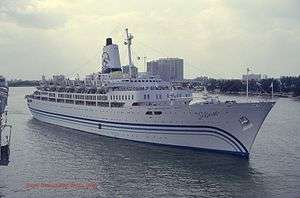Dolphin Cruise Lines
Dolphin Cruise Lines was a shipping line that owned a fleet of ships such as the SS Dolphin IV, SS OceanBreeze, SS SeaBreeze and SS IslandBreeze. In 1997, it was bought out by Premier Cruise Line, and all the ships kept their names, but were put in Premier Cruise Line colors.
Former Fleet
| Ship | Built | In service for Dolphin Cruise Line | Tonnage | Status as of 2015 | Image |
|---|---|---|---|---|---|
| Dolphin IV | 1956 | 1984– 1995 | 8,977 GT | Scrapped in 2003. | |
| OceanBreeze | 1955 | 1992–1997 | 20,204 GRT | Previously Southern Cross, Calypso, and Azure Seas. Sold for scrap In 2003. |  |
| SeaBreeze / SeaBreeze | 1958 | 1983–1997 | 21,000 GT | Previously Federico C for Costa Cruises. Sank in 2000. |  |
| IslandBreeze | 1962 | 1996–1998 | 26,632 GRT | Also known as Transvaal Castle, S.A. Vaal, and Festivale. Sold for scrap in 2003. |  |
Disasters
The disaster that happened related to this company was the recent loss of the Sea breeze which sank in a storm.[1]
In December 2000, it sank off the coast of North Carolina/Virginia . when the ship's boiler allegedly broke off and damaged the ship. The investigation into the sinking of the Seabreeze I caused international concern, based upon numerous suspicious incidents, including the fact that the ship was likely to fetch only between $5 and $6 million for scrap, but had a $20 million insurance policy on it.
The cruise ship sank in international waters flying the Panamanian flag, making Panama responsible for the investigation of the sinking of the boat. The ship's captain told U.S. Coast Guard rescuers that his boat was in imminent danger of sinking as a result of its engine room being flooded in high winds and 25-foot seas. At the time, the Coast Guard rescuers believed that it was highly unlikely for a ship that large to sink that quickly, and were astonished when the Greek captain demanded that he be exfiltrated from his boat, rather than stay aboard it and try to shepherd it to shore and recovery. Subsequently, all 34 crew members were rescued; there were no passengers on board. At the time of the sinking, Steven Cotton of the International Transport Workers' Federation in London stated that he wished that the ship, which went down 225 nautical miles (417 km) off the Virginia coast, had gone down 25 nautical miles (46 km) closer to the coast because that would have put the case in the hands of American investigators.[2]
References
- ↑ Fredhenderson-1045. "Passenger Ship Disasters - Part 5". Ships Nostalgia. Retrieved 30 October 2013.
- ↑ "WRECK WRAK EPAVE WRACK PECIO". W R E C K SITE. Retrieved 30 October 2013.